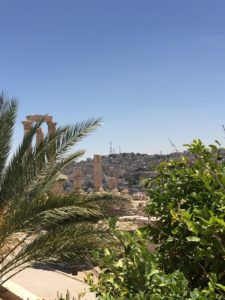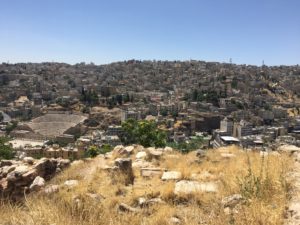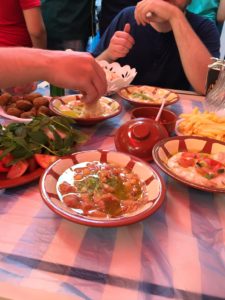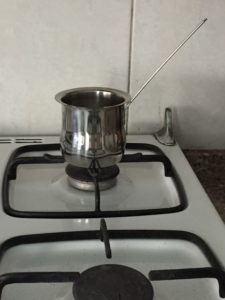Ahlan w sahlan mn al-Ordan! I landed in Amman – the capital of the Hashemite Kingdom of Jordan – on Tuesday evening and have been settling nicely into the city. I am in an apartment in mentaqat al-Rashid (منطقة الرشيد) nearby Sport City in northwest Amman. My apartment is filled with four students with whom I will be studying with at the nearby Qasid Institute.

Since landing, we have had several free days. We made sure we explored some of Amman’s cultural heritage in al-Balad – the historic downtown. Perched on the top of a hill named Jabal al-Qala’a (جبل القلعة), the citadel houses an impressive array of ruins including a Roman temple, prehistoric caves, and an

Ummayad palace. Below the mountain, we viewed the impressive Roman Amphitheater and sprawling souq. At the souq you can buy anything you can haggle for; however, I need to improve my spoken Arabic skills before I bargain for an eggplant!
In Al-Balad, you can find a number of restaurants serving delicious Arab foods. However, the real spot to eat at is Hashem Restaurant. Situated in an alleyway sandwiched between two buildings, Hashem is an unassuming spot where all the locals go to get their food fix; even King Abdullah is a fan! Our waiter served us a spread with all the classics served in bowls with olive oil. This includedhummos (حمص), the famed chickpea and tahini puree; baba ghanouj (بابا غنوج), hummos’ cousin made with eggplant in lieu of chickpea;falafel(فلافل), a fritter made of either chickpea or lima bean; sabaha(سباحة), a warm chickpea puree that’s similar albeit not identical to hummos [there is no tahini]; and ful(فل), a warm bean puree. All of these must be eaten with a nice warm piece of Arabic bread (خبز العربي)– a flat bread that sometimes, albeit not always, equivalent to pita bread.

Despite being ancient and ubiquitous in the Levantine region, these foods have no history or legend the way pizza does in Italy. However, the accessibility of the ingredients used (sesame seed paste [tahini], chickpeas, eggplant) has made these food very cheap and popular; in fact, our scrumptious and enormous lunch for four cost us only 9 JD. Because of that, foods such as hummos have become the de facto “food for all classes” that even the poorest of Jordanians can afford.
While anyone can mix the ingredients together, only certain places can have the best ratio between chickpeas, lemon juice, tahini, and spices. Hashem Restaurant is that place in Amman (and perhaps in all of Jordan). The nutty hummos and baba ghanouj are perhaps the best in the country and produce a creamy, rich taste and texture when eaten. That said, I should not get used to eating this food regularly; it is known to be highly unhealthy and is akin to Middle Eastern fast food. Around our apartment, a number of take-away restaurants will serve falafel wrapped in bread with hummos and salad with a yogurt sauce – the perfect snack for lunch!

Even in our apartment we are becoming accustomed to local foods! Every day, we take a walk to the local mokhobz(مخبز)or bakery to get local Arabic bread we eat for breakfast with lebnah(لبنه)– an Arab dairy product that is a cross between yogurt and cream cheese. Additionally, we bought a small coffee pot to make Arab-style coffee – a blend of coffee and cardamom. While we are still perfecting the process of brewing the coffee – which is simply added to boiling water while continuing to heat the pot – the strong coffee served in a small espresso-like glass is a great way to start the day!
Tomorrow is the first day of Arabic classes. While I am nervous to begin, I am also excited to begin expanding my vocabulary and hopefully gaining new friends both through class and involvement with the local community!